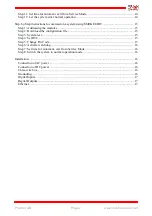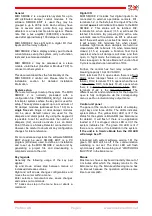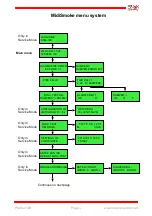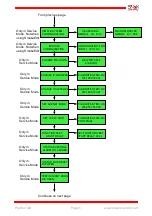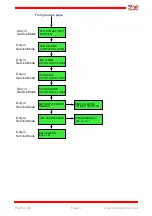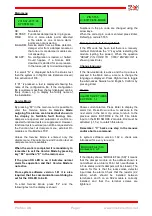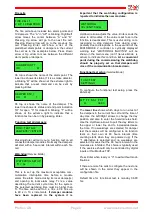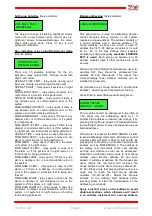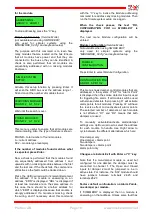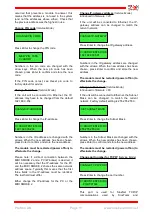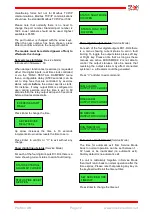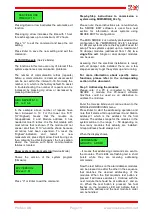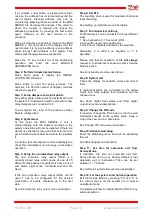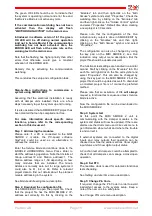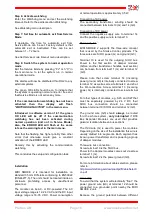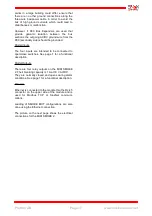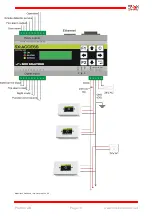
Pressing
Down
arrow inactivates the automatic exit
function.
Pressing
Up
arrow increases the time with 1 hour
for each keypress up to a maximum of 72 hours.
Press “
C”
to exit the command and keep the old
setting.
Press
Enter
to save the new setting and exit the
command.
Set SIOX Repeats
(Service Mode)
The functions in this menu are only of interest if the
system experiences communication problems.
The number of communication retries (repeats)
before a communication is deemed unsuccessful
can be set within the interval 3-30. Normally the
number is 3, which is the factory default. To assist
in troubleshooting the number of repeats can be
increased by pressing
Up
arrow or decreased by
pressing
Down
arrow.
In the example above number of repeats have
been increased to 10. For the lower line “H:5”
(“H”=Highest) means that the module on
Groupaddress 0 and Module address 8 has
needed at most 5 retries. It is the first module with
most retries that is shown. If the module did not
answer at all then “H:10” would be shown because
all retries had been expended. To reset the
“Highest”-indication and restart a new
measurement, press
Right
arrow. Fault tracing can
then primarily be directed against the bus section
where the module with most communication
failures is located.
Show system program version
(Service Mode)
Shows the version of the system program
(firmware).
Press “
C”
or
Enter
to exit the command.
Step-by-Step instructions to commission a
system using MIDISMOKE_02.cfg
Please note: these instructions are not valid when
the SMOKE EDIT software is used. See next
section for information about systems using
SMOKE EDIT for configuration.
The MIDI SMOKE 2 is normally preloaded with a
configuration file (“MIDISMOKE_02.cfg”) intended
for simpler systems where the key pad is used for
setup. These systems support up to a maximum of
59 damper modules (addressed from 1-59)
in a
single fire cell
. Single or dual damper modules
can be used.
Assuming that the electrical installation is ready
with all damper units installed, there are a few
steps necessary to get the system up and running.
For more information about specific menu
functions, please refer to the corresponding
section in this document.
Step 1: Addressing the modules
Please note: if a PC is connected to the MIDI
SMOKE 2 module, the PC-based software
SioxTools could be used as an alternative to
address the modules.
Enter the
Service Mode
and continue down to the
MODULE ADDRESSING
menu.
Press
Enter
to start the addressing operation and
note that it starts at Group Address=0 and Station
Address=1 which is the address for the first
module. The address range for the modules in the
system will be in the range 1 – 59 depending on
how many modules that actually are installed.
Group Address should always be 0.
When the display shows...
...it means that addressing commands are sent to
the modules. Their LEDs are flashing red in short
bursts while they are receiving addressing
commands.
Now the test buttons on the alarm/damper modules
can be pressed one after the other in the sequence
that matches the desired addressing of the
modules. When the first module's test button is
pressed it will receive address 1. Continue with the
next module that should be at address 2, and so
on. When the test button is pressed, five fast
flashes on the module's LED will indicate that it
received the address and the next module in order
can be handled.
Profcon AB
Page 13
www.smokecontrol.net
ADDRESSING
GROUP:0 ADDR:1
EX2 VERSION:
EX2 ver 1.61
SERVICE MODE
TIMEOUT 1 h
SIOX REPEATS:10
H:5 G:0 A:8


